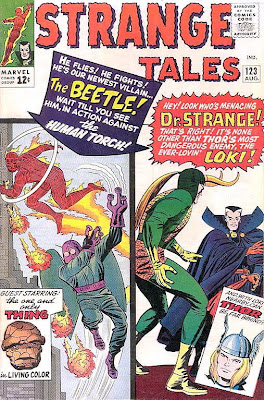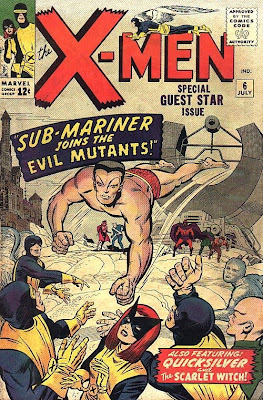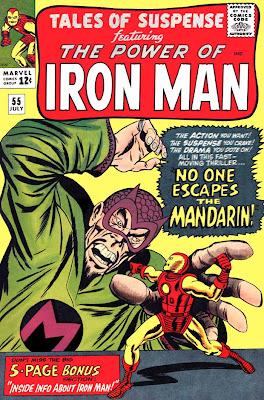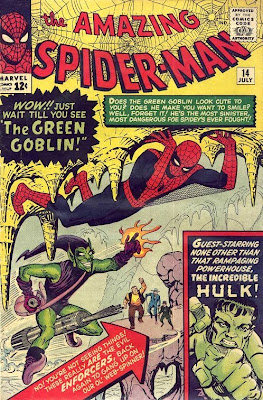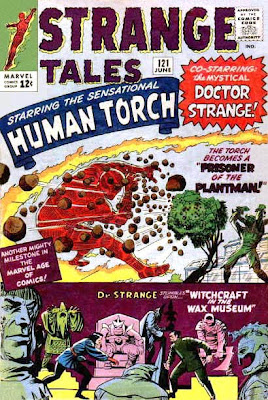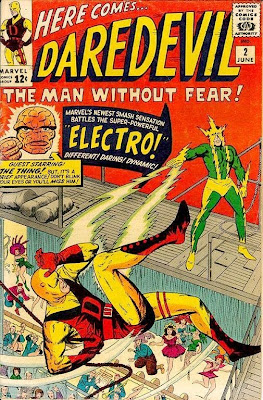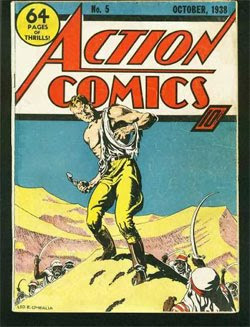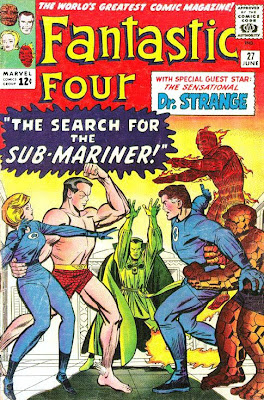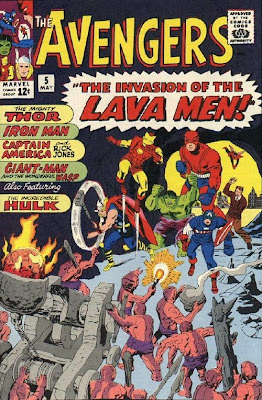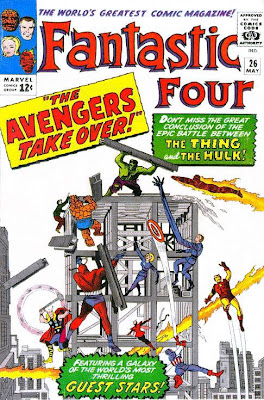
FANTASTIC FOUR #26
This one picks up right where the last issue left off, with Ben shrugging off the beating Hulk gave him and renewing the battle.
We get what
might be the first occurance of a common comic book trope here--the fight
just happens to take place in a condemned neighborhood, where the good guys don't have to worry about innocent bystanders or property damage.
This sort of thing happens with unlikely frequency through the years--but it's a perfectly acceptable cliche. Often, a good fight sequence can be constructed around the hero's need to protect innocent lives, but it's good to leave the artist the freedom to simply allow the characters to go after each other and just wreck/blow up a lot of stuff.
Anyway, the injuries Johnny suffered last issue prove to be relatively minor (though he does wear one arm in an asbestos sling for much of the story) and the doctors manage to whip up a serum that cures Reed. So the FF is back together again.
And then the Avengers show up. There's a great "fight" sequence in which members of the two groups get in each other's way when they try to attack the Hulk, allowing the green guy to snatch Rick Jones and leap atop a partially contructed building. Even after the two groups team up for the final showdown, they still manage to stumble over each other once or twice.
All this makes for another wonderful fight scene, which ends in a more-or-less draw when the Hulk turns back into Bruce Banner and manages to slip away. Jack Kirby once again manages to highlight nearly ever hero for at least a panel or two.
There's some great characterizations as well, as it's made clear at several points that each member of the Fantastic Four (including Ben) really cares and appreciates the others.
I also like that neither the FF or the Avengers are just mindlessly trying to beat down on the Hulk. Everytime they encounter him, they try to talk before they fight. But the Hulk is just too darn mad over what he sees as Rick's betrayal to listen. This is something that will be followed up on in this month's
Avengers.

SPIDER MAN #12
Doctor Octopus, still on the loose after the last issue, goes on a cross-country crime spree, hoping lure Spider Man to him so he can have his revenge. But poor Peter Parker has to study for mid-terms and, besides, he doesn't have enough money for bus fare to pursue the supervillain.
Frustrated, Doc Ock returns to New York and kidnaps Betty Brant (who has returned to work at the Daily Planet). This
does lure Spider Man to him, but the luckless webslinger has caught the flu and is weak as a kitten.
In fact, he puts up such a weak fight that no one believes he
really is Spider Man, so when Ock knocks him out and unmasks him, everyone just assumes that Parker has dressed up as Spidey in a desperate attempt to save Betty.
The next day, finally over his flu, Peter discovers his supposed act of bravery has impressed Liz Allen--which annoys Flash Thompson. But Pete has no time to deal with all that nonsense. Ock is on another rampage, releasing animals from the zoo and overturning cars in yet another attempt to bring Spider Man to him.
This leads to yet another great fight scene--this one beginning with Spidey rounding up the escaped animals, then going into a running battle across the rooftops. The finale is in a burning artists' studio, surrounded by huge, grotesque statues. It's fast-moving, visually fun, allows Spidey to use his webbing in several tactically interesting ways and ends with Ock in custody yet again.
I know I'm repeating myself
ad naseam about how cool the fight scenes are both here and in
Fantastic Four, but it simply continues to be true and is an important part of what made Marvel comics of this era so entertaining and memorable.
There's a neat bit of business involving J. Jonah Jamison. When Betty is kidnapped, he puts out an extra asking Spider Man to contact him and get instructions on where to find Ock. He also sends Peter Parker to get photos, but doesn't tell the cops (so the
Bugle can have an exclusive.) After Ock gets away from that particular debacle, a cop give Jonah a really nasty dressing down about not reporting the crimes right away. Once again, we see that Lee and Ditko seem determined to give every cast member some depth---whether this shows them to be good or bad.

STRANGE TALES #120
Johnny Storm and Bobby Drake just happen to be on the same cruise ship when some modern day pirates come aboard to loot the passengers. What follows is a straight-forward and entertaining action set piece. The sheer number of pirates and a clever leader combine to believably give the heroes a hard time before the villain are all rounded up.
Meanwhile, Doctor Strange decides to keep an eye on a reporter who is broadcasting live from a reputed haunted house. But the house isn't traditionally haunted--Strange himself comments that there are things out there more dangerous than ghosts. This proves true as the story leads up to an interesting twist at the end.
That's it for now. Next week, we'll look in on Thor, Iron Man and Giant Man.







